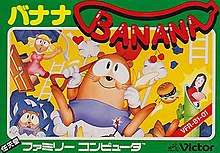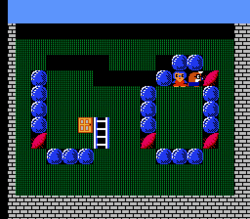Banana (video game)
Banana (バナナ) is a fixed screen puzzle video game produced by Victor Musical Industries that was released exclusively for the Family Computer in Japan in 1986.[2]
| Banana | |
|---|---|
 Cover art | |
| Developer(s) | Victor Musical Industries[1] |
| Publisher(s) | Victor Musical Industries[1] |
| Platform(s) | Family Computer |
| Release | |
| Genre(s) | Puzzle[1] |
| Mode(s) | Single-player |
Gameplay

The player gets to control a mole which digs through dirt collecting various fruits and vegetables.[1] In most stages, the produce must be collected in a specific order, or the player may become stuck and be forced to restart the stage. During the stages, the player must also retrieve a female mole;[1] referred to in the instruction manual as the player's daughter-in-law.[3] When all objectives are complete, the player must make his way to the exit.[1] If the player dies, his character says something along the lines of "I'm beat.[2]"
Among the fruits the player must collect are bananas.[1] These are special fruits which give the player one of four items: a bomb, a ladder segment, a rope, or a rock. The player may use these if he takes a misstep in a stage and gets stuck. If a player walks under a rock, that rock shakes. When the player moves out from under the rock, the rock and any rocks on top of it fall. The player cannot die from a falling rock, but he may become stuck if it blocks his exit. There are 105 stages in Banana.[4] Both of the final stages of the game loop from left to right; meaning that it is possible to quickly warp from one part of the level to another.[5] Each stage progressively becomes more difficult. At the end of each stage, the number of steps the player took is totaled. This step count negatively affects the total score. A complete textual walkthrough of all 105 stages is available, as are demonstration videos for the first several stages.[6]
Players can even design their own levels; controlling several factors. All the produce that is available in the game can be used and the size of the map can even be controlled. With the original Famicom system, players can save their creations to a specially formatted cassette tape. After completing the design, players can immediately play in their new creation.[7]
References
- Banana game overview at MobyGames
- "Banana (NES translation cartridge)". Archived from the original on 2013-06-23. Retrieved 2012-01-19.
- Basic gameplay information (in Japanese) at GeoCities.jp
- Levels of Banana (in Japanese) at GeoCities.jp
- Information about the final two stages (in Japanese) at FC no Game Seiha Shimasho
- YouTube: Nes - Banana (1986)
- Excerpt from Banana instruction manual (in Japanese) at GeoCities.jp